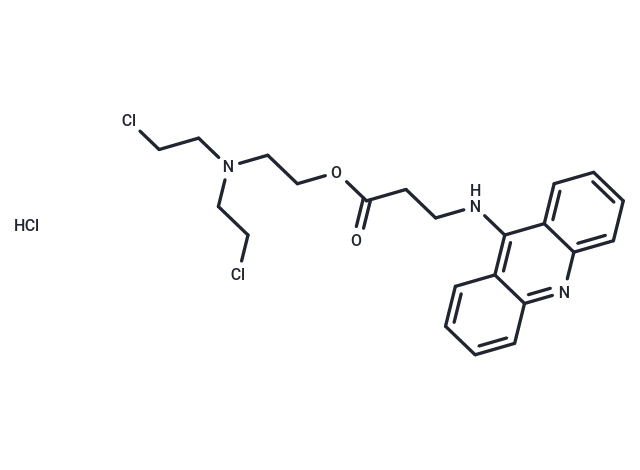Shopping Cart
Remove All Your shopping cart is currently empty
Your shopping cart is currently empty
Amustaline (S-303) dihydrochloride is a nucleic acid-targeted alkylator recognized for its efficacy as a pathogen inactivation agent in blood components containing red blood cells. This compound comprises three key elements: an acridine anchor (a non-covalently bonding intercalator targeting nucleic acids), an effector (a bis-alkylator group that interacts with nucleophiles), and a linker (a flexible carbon chain with a labile ester bond, hydrolyzing at neutral pH to non-reactive products).

| Pack Size | Price | USA Warehouse | Global Warehouse | Quantity |
|---|---|---|---|---|
| 25 mg | $1,120 | Inquiry | Inquiry | |
| 50 mg | $1,820 | Inquiry | Inquiry | |
| 100 mg | $2,820 | Inquiry | Inquiry |
| Description | Amustaline (S-303) dihydrochloride is a nucleic acid-targeted alkylator recognized for its efficacy as a pathogen inactivation agent in blood components containing red blood cells. This compound comprises three key elements: an acridine anchor (a non-covalently bonding intercalator targeting nucleic acids), an effector (a bis-alkylator group that interacts with nucleophiles), and a linker (a flexible carbon chain with a labile ester bond, hydrolyzing at neutral pH to non-reactive products). |
| In vitro | S-303 (200 μM; 20 h) and glutathione (GSH; 20 mM) effectively inactivate high levels of Chikungunya virus (CHIKV) in red blood cells (RBCs)[1]. Additionally, the combination of S-303 (200 μM; 20 h) and GSH at different concentrations demonstrates significant inactivation capabilities against various pathogens in whole blood and RBC experiments: it inactivates more than 6.5 logs of HIV, over 5.7 logs of Bluetongue virus, more than 7.0 logs of Yersinia enterocolitica, 4.2 logs of Serratia marcescens, and 7.5 logs of Staphylococcus epidermidis in whole blood[2], as well as roughly 5 logs or more of Y. enterocolitica, E. coli, S. marcescens, S. aureus, HIV, bovine viral diarrhoea virus, bluetongue virus, and human adenovirus 5 in RBCs[2]. Furthermore, S-303 maintains in vitro RBC function and physiology, preserving total ATP, extracellular potassium, hemolysis levels, glucose consumption, lactate production, and pH at 37 °C, aligning with conventional RBC standards[2]. |
| In vivo | S‐303 RBCs, both in single transfusion doses of 50 μmol/kg for rats and 70 μmol/kg for dogs, and in repeated transfusion doses of 10 μmol/kg for both rats and dogs, have been found to be well tolerated. There is no histopathologic evidence of organ toxicity in these animals[3]. |
| Synonyms | S-303 dihydrochloride |
| Molecular Weight | 470.82 |
| Formula | C22H26Cl3N3O2 |
| Cas No. | 210584-54-6 |
| Smiles | Cl.ClCCN(CCCl)CCOC(=O)CCNc1c2ccccc2nc2ccccc12 |
| Relative Density. | no data available |
| Storage | Powder: -20°C for 3 years | In solvent: -80°C for 1 year | Shipping with blue ice/Shipping at ambient temperature. |
| Size | Quantity | Unit Price | Amount | Operation |
|---|

Copyright © 2015-2026 TargetMol Chemicals Inc. All Rights Reserved.